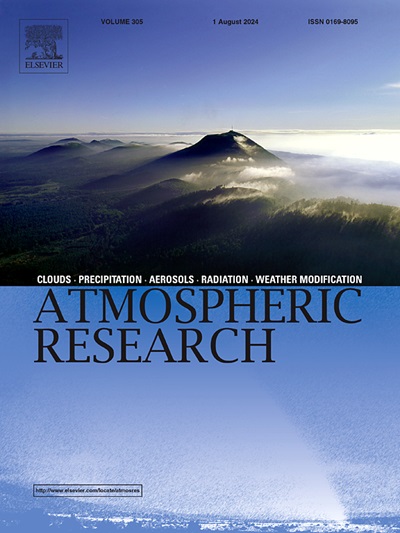阿塔卡马沙漠的雾类型频率及其集水潜力
IF 4.5
2区 地球科学
Q1 METEOROLOGY & ATMOSPHERIC SCIENCES
引用次数: 0
摘要
雾是阿塔卡马沙漠沿岸的一种普遍现象。在这一地区,已经描述了三种类型的雾:平流雾、风化雾和辐射雾。然而,关于它们的频率、形成的物理机制以及它们对雾水收集的贡献,仍然缺乏量化。我们的研究首次量化了阿塔卡马沙漠中每种雾的频率、有利于其形成的物理条件及其集水潜力。利用高时间分辨率(10 分钟)的 GOES 卫星图像,我们确定了与不同类型雾的常规存在区域相关的地理标准,从而能够在多个时间尺度上分析它们的频率。我们的研究结果表明,平流雾占雾事件总数的 76%,气流雾占 22%,辐射雾占 2%。海面温度和热反转层是形成平流雾和风化雾的主要物理机制,而辐射雾的形成主要受海洋边界层高度的控制。在月尺度上,平流雾占集水量的 60%,而风化雾占 40%。在昼夜尺度上,风化雾的每小时集水率更高。这种反演受到风速等局部尺度变量的影响,风速在昼夜尺度的集水过程中起着至关重要的作用,它增强了下午时段的气压雾形成及其相对贡献。我们的研究加深了人们对雾这一空间气象现象和潜在水资源的理解,为全球沿海干旱地区的雾类型分类提供了一种简单明了的方法。本文章由计算机程序翻译,如有差异,请以英文原文为准。
Fog types frequency and their collectable water potential in the Atacama Desert
Fog is a widespread phenomenon in the coastal Atacama Desert. Within this region, three types of fog have been described: advective, orographic, and radiative. However, there remains a lack of quantification regarding their frequencies, the physical mechanisms responsible for their formation, and their contribution to fog water collection. Our research quantifies for the first time in the Atacama Desert the frequency of each fog type, the physical conditions conducive to their formation, and their potential for water collection. Using high temporal resolution (10 min) GOES satellite imagery, we define geographical criteria related to the regular area of presence of different types of fogs that allowed us to analyze their frequencies at multiple time scales. Our results reveal that advective fog accounts for ∼76 % of total fog events, with orographic fog ∼22 % and radiative fog ∼2 %. The main physical mechanisms driving advective and orographic fog formation are the sea surface temperature and the thermal inversion layer, whereas for radiative fog formation, it is mainly controlled by the marine boundary layer height. On a monthly scale, advective fog contributes to 60 % of water collection, while orographic fog accounts for 40 %. At the diurnal scale, orographic fog has a higher collection rate per hour. This inversion is influenced by local-scale variables such as wind speed, which plays a crucial role in water collection on a diurnal scale, enhancing orographic fog formation and its relative contribution during afternoon hours. Our research enhances the understanding of fog as a spatial-meteorological phenomenon and a potential water resource, offering a straightforward methodology for classifying fog types in coastal arid regions worldwide.
求助全文
通过发布文献求助,成功后即可免费获取论文全文。
去求助
来源期刊

Atmospheric Research
地学-气象与大气科学
CiteScore
9.40
自引率
10.90%
发文量
460
审稿时长
47 days
期刊介绍:
The journal publishes scientific papers (research papers, review articles, letters and notes) dealing with the part of the atmosphere where meteorological events occur. Attention is given to all processes extending from the earth surface to the tropopause, but special emphasis continues to be devoted to the physics of clouds, mesoscale meteorology and air pollution, i.e. atmospheric aerosols; microphysical processes; cloud dynamics and thermodynamics; numerical simulation, climatology, climate change and weather modification.
 求助内容:
求助内容: 应助结果提醒方式:
应助结果提醒方式:


